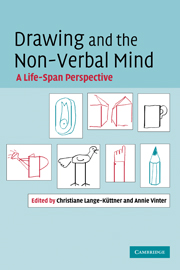Book contents
- Frontmatter
- Contents
- Contributors
- 1 Contemporary enquiries into a long-standing domain: Drawing research
- Part I Self, symbols and intention
- Part 2 Syntax, space systems and projection
- 7 The interaction of biomechanical and cognitive constraints in the production of children's drawing
- 8 Graphic syntax and representational development
- 9 Spatial structures in children's drawings: how do they develop?
- 10 Figures in and out of context: absent, simple, complex and halved spatial fields
- 11 Spatial and symbolic codes in the development of three-dimensional graphic representation
- 12 On contours seen and contours drawn
- Part III Aging, blindness and autism
- Index
- References
7 - The interaction of biomechanical and cognitive constraints in the production of children's drawing
Published online by Cambridge University Press: 22 September 2009
- Frontmatter
- Contents
- Contributors
- 1 Contemporary enquiries into a long-standing domain: Drawing research
- Part I Self, symbols and intention
- Part 2 Syntax, space systems and projection
- 7 The interaction of biomechanical and cognitive constraints in the production of children's drawing
- 8 Graphic syntax and representational development
- 9 Spatial structures in children's drawings: how do they develop?
- 10 Figures in and out of context: absent, simple, complex and halved spatial fields
- 11 Spatial and symbolic codes in the development of three-dimensional graphic representation
- 12 On contours seen and contours drawn
- Part III Aging, blindness and autism
- Index
- References
Summary
Research investigating the process of drawing has often been overshadowed by a focus on the end product of this process. However, it is important to acknowledge that various factors that shape the process also impact on the final drawing outcome. In this chapter, Braswell and Rosengren examine how biomechanical, cognitive and contextual factors shape how children and adults draw. For example, the physiology and structure of the fingers, hands and arms often influences the direction in which strokes are produced on a page. Numerous studies demonstrate the effect of handedness on drawing horizontal lines, for instance. Other research has demonstrated that cognitive factors shape where drawers begin figures and the direction in which strokes are produced. In some cases, drawers rely on relatively stable, procedural representations to guide the sequencing and placement of strokes for entire images. Contextual factors, such as writing systems, also play important roles in determining how individuals construct a drawing. They discuss these factors and how they interact using the TASC-based approach, which views development as driven by constraints internal and external to the individual.
drawing is a complex skill that emerges during the second year of life, changes significantly over the course of childhood, and involves both higher-order symbolic processes and a motor system capable of producing a desired representation in the real world. Much of the research on children's drawings has focused on the cognitive aspects of children's drawing, often with an emphasis on the final product of a drawing episode.
Information
- Type
- Chapter
- Information
- Drawing and the Non-Verbal MindA Life-Span Perspective, pp. 123 - 138Publisher: Cambridge University PressPrint publication year: 2008
References
Accessibility standard: Unknown
Why this information is here
This section outlines the accessibility features of this content - including support for screen readers, full keyboard navigation and high-contrast display options. This may not be relevant for you.Accessibility Information
- 7
- Cited by
